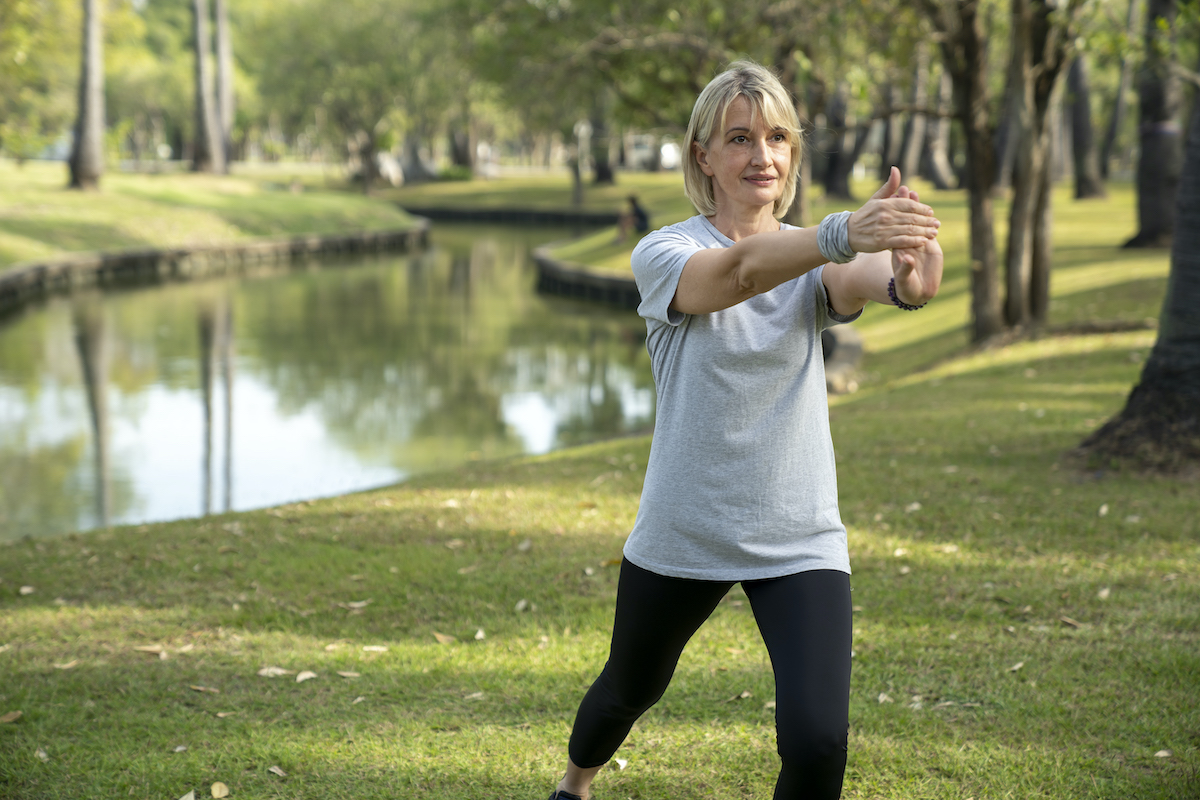7 Fun Things to Do Alone
Here’s how even the most extroverted people can learn to love their alone time.

It’s hard to overstate the importance of social connections. Lacking quality relationships, whether with family or friends, has been linked to increased risk of heart disease, depression, cognitive decline and dementia, and even early death.
So there’s no question: Nurturing existing relationships or forging new ones—no matter your age—is a good idea. But that doesn’t mean you can (or should) be surrounded by friends and family all day, every day.
One thing we all learned from the coronavirus pandemic is that sometimes you may find yourself with much more alone time than you expected, no matter how big your social circle. So there’s a lot of value in learning to enjoy your own company.
Ready to make a date with yourself? Here are seven suggestions for solo activities that can make even the most extroverted people love their alone time.
Add SilverSneakers to your wellness routine! Classes and events are happening right now at participating gyms, online through SilverSneakers LIVE, and at community centers near you. Activate your free online account to get started.
Solo Activity #1: Learn a New Skill from YouTube
Think about a skill you’ve always found a little intimidating—sharpening a knife, making pasta from scratch, or reupholstering a chair, for example. Then commit to watching a YouTube tutorial on how to do it, suggests Hillary Schoninger, L.C.S.W., a licensed clinical social worker based in Chicago.
“It can be very empowering to master a hack or hobby, particularly if you think it’s out of your reach,” she says. And often, it ends up being much easier than you expect.
Even better, don’t stop at just one skill. According to research published in The Journals of Gerontology, people ages 58 to 86 who learned at least three new skills at once (Spanish, drawing, and music composition, for example) improved their cognitive abilities to a level on par with a separate sample of middle-aged adults 30 years younger.
What you decide to tackle doesn’t have to be major. Study participants did everything from learning to use an iPad to basic painting skills.
Solo Activity #2: Laugh (Yes, That’s It)
Laughter really is the best medicine. A good chuckle can help reduce stress, keep your immune system healthy, and even ease pain, likely by causing your body to release its own natural painkillers.
“Take a stroll down memory lane by watching something that has made you laugh out loud in the past,” suggests Heidi Hanna, Ph.D. She’s chief energy officer of Synergy Brain Fitness in San Diego.
This might be your favorite comedian’s stand-up routine (you can either go in person if you feel comfortable or queue it up on Netflix or another streaming service), or simply look through saved videos on your phone to find a funny moment you—or someone else—captured in the past.
Can’t find anything that gets you giggling? Google “funny dog videos.” You’re welcome.
Solo Activity #3: Read a Book from the Year You Were Born
If you’re already an avid bookworm, reading just anything may not feel new or exciting. That’s why Schoninger recommends finding a book that was originally published around the year you were born.
Books such as A Tree Grows in Brooklyn by Betty Smith (1943), The Old Man and the Sea by Ernest Hemingway (1952), and Lolita by Vladimir Nabokov (1955) may inspire you to take a break from your go-to genres and expand your literary interests. Plus, you might learn something new about a time period you lived through but don’t remember well.
Solo Activity #4: Make a Recipe Attached to a Happy Memory
There’s no shortage of recipes available online, which is why finding something new to make can be overwhelming. Schoninger’s suggestion: Pick a region you once traveled and loved or have lusted after from afar, and then search for an associated recipe.
Dreaming of an escape to a Greek island? Try spanakopita (spinach pie) or dolmadakia (stuffed grape leaves). Have fond memories of a trip to France? Channel your inner Julia Child and try making beef bourguignon.
If regional cuisine doesn’t get you excited, consider making a meal you loved as a child, Hanna suggests. Once you’ve mastered it during your solo time, add a social element by teaching one of your kids or grandkids how to make it to carry on the tradition.
Solo Activity #5: Knit (or Crochet) for a Good Cause
If you can knit or crochet, consider using your skills to give back, Schoninger says. Charities such as Crochet for Cancer deliver knitted and crocheted caps and other items such as socks to patients going through chemotherapy, while Warmth for Warriors sends hats to soldiers both active and retired.
You’ll not only help others, but research published in TheJournal of Neuropsychiatry and Clinical Neurosciences suggests that engaging in crafts such as knitting and crocheting may also help stave off a decline in brain function as you age. It’s a win-win!
Subscribe to our newsletter
It's quick and easy. You could be one of the 13 million people who are eligible.
Already a member? Click to discover our 15,000+ participating locations.
Follow Us
Solo Activity #6: Try Forest Bathing
This sounds more risqué than it really is. Forest bathing (or shinrin-yoku) is the Japanese practice of taking in nature through your senses—noticing the scent of trees, the sunlight on your face, the sound of birds chirping, and the feeling of the earth beneath your feet.
It’s more than simply being outside. It’s about being present and appreciating the natural world around you. And according to Hanna, it’s one of the best ways to spend time alone.
Science supports this. Numerous studies have shown that spending time in nature has real health benefits, including reduced risk of type 2 diabetes, cardiovascular disease, high blood pressure, and even early death.
How does one go about forest bathing? Start by leaving all your devices at home, and then find a spot outside where you can walk aimlessly and slowly. Take your time and notice the sounds, smells, and sights around you.
You shouldn’t have any agenda beyond observing nature with all five senses. It’s best if you don’t have any time constraints. But if that’s not possible, set aside at least 30 minutes (and use a watch to keep tabs, not your phone).
Solo Activity #7: Take Up Yoga or Tai Chi
Yoga and tai chi offer many health benefits, from improving balance and mobility to relieving depression and reducing blood pressure in people with hypertension. In other words, just about anyone can benefit from trying one or both, Hanna says.
Not sure which is best for you? The main difference is in execution. Yoga often involves holding poses and postures that target specific muscles and joints. Tai chi is performed as a series of slow, choreographed movements, almost like a dance. Both can be rigorous or low impact, depending on your fitness level.
Contrary to popular belief, you don’t need to be flexible or super coordinated to try either. You can roll out your mat in your living room and follow along with this 15-minute energizing routine or this gentle tai chi practice. If you’ve been missing group fitness classes, sign up for a virtual class such as SilverSneakers EnerChi or SilverSneakers Yoga.
Take Your Favorite SilverSneakers Classes Online!
SilverSneakers members can access live fitness classes and wellness workshops through SilverSneakers LIVE. See the latest schedule and RSVP for classes here.
Not a member? If you have a Medicare plan, it may include SilverSneakers—at no additional cost. Check your eligibility instantly here.





